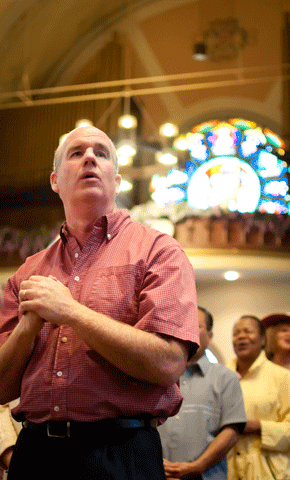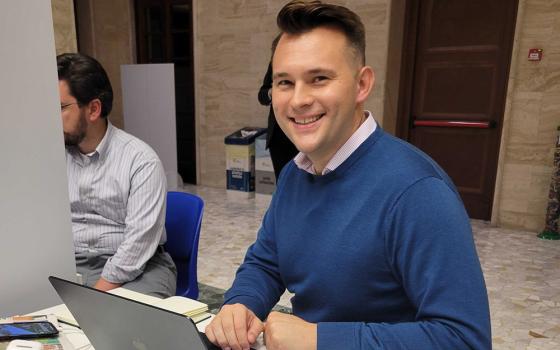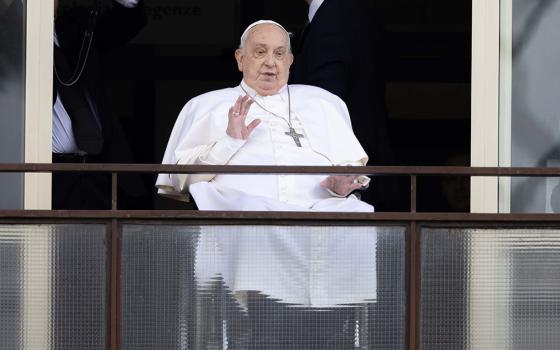
Parish life director Steve Mullin at Mass at All Saints Church in Hayward, Calif. (J.P. Cruz)
Standing in the pulpit, he holds the out-of-town parish bulletin with two disdainful fingers: "When I travel, I go to other parishes and I find their bulletins ..." he offers a brief sigh, for effect, "... boring. They don't even make it back to my car; right into the nearest trashcan. Your bulletin is anything but boring: Our CYO is trolling for public school kids so they can find God in our gym; your bipolar support group helps folks find healing; we were at the Castro Valley Pride parade carrying a big 'All Saints' sign. Over and over we are making sure the world knows that All Saints lives up to our motto: We say yes to God. You hear me," his voice now rising, "yes ... to ... God!"
With his knit shirt and tan slacks, Steve Mullin could not be mistaken for any other than the layman he is. But he is a layman like only a few hundred others in the American church. As the parish life director of All Saints in Hayward, Calif., his name is atop those of the two assigned priests in that weekly bulletin he just extolled (and which he edits), and his is the message on the opening page they read each week. If you ask any All Saints parishioner who their pastor is, it is Mullin, married and the father of four children.
His is a vibrant parish.
His is an endangered vocation the church doesn't quite know what to do with.
Mullin came to All Saints 12 years ago, appointed by now retired Bishop John Cummins. At about the same time, four pastoral life directors, both men and women, with requisite skills and ministry experience were appointed in Oakland. It was part of a nationwide mini-trend, beginning in the 1980s, at a time when projected shortfalls in active priests forced bishops to consider how to staff parishes with qualified pastors. Many expected the trend to grow, but that prediction has not come to pass. Today, Mullin is the only pastoral life director in his diocese.
In 2005, according to the Center for the Applied Research in the Apostolate (CARA) there were 553 parish life coordinators nationwide, in parishes canonically entrusted to a deacon, religious sister or brother, or, like Mullin, a layperson. As they retired, were encouraged to leave or otherwise left parish leadership, the number has declined to 428 in 2012.
In the same period, the number of parishes without a resident pastor rose from 2,843 to 3,554 and is expected to grow.
Although bishops who did appoint parish life coordinators have generally expressed satisfaction with their performance, few dioceses have appointed more, even as parishes close and priests take on multiple parishes. Why? And will the reign of Pope Francis make a difference?
"Bishops basically don't trust people they have not ordained, people whose obedience and obeisance might be in question, who don't toe the company line, people they cannot directly control," a church social science researcher told me, asking to remain anonymous. "It seems like a no-brainer that when you have a group of educated men and women who are not priests but who have performed so well, you would go back to that well for more. Instead of stretching priests to cover two and sometimes three parishes, instead of closing small but vital and financially secure parishes. I just don't get it."
Church on the hill
All Saints truly is the church on the hill, a breathtaking, beautiful Hayward landmark as B Street gently rises, leaving the central city. It was built in 1868, reflecting the Spanish Renaissance, modeled after Spanish cathedrals. It was once home to the rich and powerful in Hayward, but as the city's manufacturing base eroded, the parish faced diminished resources. It is now more a blue-collar parish, although still with a base of middle-class parishioners.
What struck me about All Saints and Mullin when I recently visited Hayward was that I had completely missed this parish and this kind of lay-led model in my Lilly Endowment study that eventually became the book Excellent Catholic Parishes: The Guide to Best Places and Practices. It was a glaring oversight.
All Saints is a highly viable alternative structure as demonstrated by the welcoming, dynamic parish I found, albeit struggling with a changing population and financial constraints. Beyond being incredibly alive, not just in numbers and reach of ministries, All Saints manifests a non-clerical, lay-driven "corporate culture" that Mullin has instilled.
Looking at a richly diverse population of Tongans, Igbo, Filipinos, Chamorro, Latinos, some 20 ethnic groups in all, and diminishing collections, Mullin realized he could never support current ministries and forge new ones without more staff. So he "hired" five highly-qualified laypeople. At no pay.
"These are people with Ph.D.s and heavy resumes in technology companies and business owners, who also have rich backgrounds in ministry who want to be deeply involved in a vibrant parish," Mullin says, "and are willing to do it regardless of our ability to pay them. They are looking for the 'action' in a parish; that's what excites them, that's what brings people to All Saints. If that is a new model, then it is. What I know is that we had to do something different. And it's working."
It's easy to gauge the level of involvement and enthusiasm of the parishioners. But I wondered about the priests. There are two assigned to All Saints, but, in effect, they are responsible to Mullin, not the other way around.
"I love it," says Fr. Filiberto Barrera, who was recently assigned to the parish after serving as parochial administrator at the huge St. Cornelius Parish in Richmond. "Here I get to be priest full time. I have time to read. I don't have to worry about the roofers, who is going to paint the church or who has the keys for the storeroom."
Another path
Mullin spent three years as a seminarian, then decided not to pursue the priesthood, went into business for a while, but found himself drawn to parish ministry. His four children range in age from 17 to 24, and at a Hayward Chinese restaurant with Mullin and two of his daughters, they shrug when asked if their dad is, in effect, a married priest.
"Absolutely not," says Kate, a college junior. "Sure, he's out three or four nights a week, but so are a lot of parents. My mom works as a registered nurse. We take family trips, we eat dinner together and we argue about just everything. We are just your ordinary family."
"Look, I feel really lucky to have both ... a biological family and a parish family," Mullin says as we stand in the sunlight after one of the Sunday morning liturgies. I had watched him that morning, a peripatetic pastoral floor walker, up and down the pews before Mass, out in the courtyard between, singing with the All Saints not-exactly-renowned men's UnChoir, few of whom claim great singing voices, but band together the third Sunday of each month, then have breakfast together.
"Sure, pastoral administrators free up the priests from running a parish, but I think there is something else, both subtle and obvious: Here is a layperson doing virtually everything -- outside the sacramental -- in a parish," Mullin says. "If Steve can do this, the message gets out, why can't -- or more importantly, why don't -- I do the same?"
"We welcome people from different cultures here, but it's just not just show-and-tell, performance religion," he adds. "When the Mexicans have a celebration for Our Lady of Guadalupe, we are participants, not observers. When our parishioners carry an 'All Saints' sign in the Castro Valley Gay Pride parade, we as a parish are there marching with them."
He refuses to even consider closing All Saints School, or charge tuition that only the well-heeled could afford. This year, 50 new families enrolled their children in the 220-student school, many paying reduced or no tuition. A few of the families were homeless, Mullin says. "We are going back to the old-fashioned way," he says, "where we educate the poor, the immigrants, not just those who can pay."
Mullin has placed an emphasis on bringing younger people into active ministry -- through a Catholic Club at nearby California State University, East Bay, that has on campus liturgy, Bible study, retreats and service projects, with students then coming to the parish to teach catechism. And with the "God with a basketball" approach, Mullin, like every parish leader, strategizes on how to bring both Catholic and unaffiliated kids into the All Saints vortex.
'Stealth Catholics'
"We always talk about bringing in new people, fallen-away Catholics, the unchurched," he says. "And we do a pretty good job at that plus a top-notch orientation for people who register, introducing them to what they can do in the parish. But it gradually dawned on me after seeing the same people attending week after week that I didn't know them, registered or not. They were not going beyond the weekend liturgy to participate into the dynamic life of this parish."
Mullin's answer: He is currently training 20 to 30 parishioners ("Call them stealth Catholics if you want") who will strategically situate themselves next to one of those weekend Catholics and after Mass take them aside find out why they aren't ("No guilt, please") -- but, more importantly, how they could be -- more involved in parish.
"These are obviously committed Catholics; I think we just haven't reached out and invited them to the table."
Mullin's zest, ingenuity and organizational skills are apparent. Aren't there more like him out there to lead parishes as the number of Catholics continue to rise and qualified priest-pastors decline?
"All the surveys indicate that there are so I asked one bishop that directly," the social science researcher told me, citing the numbers of well-educated laypeople who would love to lead a parish. "And he answered it obliquely and a bit limply: that it is the priests' responsibility to make sure parishes are running smoothly. After all, every parish does have a priest canonically appointed but, of course, this was no answer at all. What it really means is: I have control over that priest; he is in the chain of command. These lay men and women, nuns and brothers, not so much."
Mullin is encouraged by the words of Pope Francis who has said that in order to bring Catholicism alive in the world, we must listen to the people of the church, not just the hierarchal church. "If I read him correctly," Mullin says, "he sees the discontent, the disconnect between people and an institution that isn't that 'field hospital for the wounded' as he said in the recent interview. He's looking to find and appoint the best and most talented people to serve in those hospitals -- namely parishes -- ordained or not. He wants laypeople to have a real say in the working and structure of church. It gives hope to all of us who have felt 'fringed,' all the people who have alienated by the church. We might be welcome; this might be our real home after all."
[Paul Wilkes has written many books on religious belief and practice. In 2006, he founded Homes of Hope to rescue, protect and educate orphan girls in India.]


